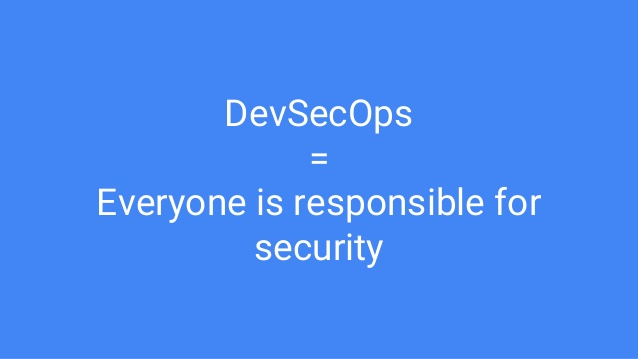Other recent blogs



Let's talk
Reach out, we'd love to hear from you!
Security is the new priority for leaders across industries. To get to the forefront of customer experience while driving revenue growth, you not only need to ship code faster, but you also need to make them secure from early on.
Enter DevSecOps. Although experts might differ in terms of how they like to define this term, what is really important is how DevSecOps focuses on embedding security controls and testing early and everywhere across the software development lifecycle.

Note: Explore the fundamentals of DevSecOps methodology
Despite its steady increase in popularity over the past few years, it can be daunting to integrate the DevSecOps philosophy in your development and deployment workflows. However, this DevSecOps best practices guide can help ease the transition for sure.
Top 5 DevSecOps best practices to build secure applications

1. Foster a DevSecOps culture and mindset
You can fail big if you do not get this first step right. No amount of tools and processes can yield the desired results unless you first invest in building a DevSecOps culture and mindset within your organization. That’s why it’s our first best practice in DevSecOps. But what is a DevSecOps culture and mindset?
The definitions are in abundance - however, the most compelling one has the following at its core: Collaboration, automation, learning, measurements, and sharing (CALMS).
The foundational blocks of DevSecOps in your organization, thus, build on how closely the cross-functional teams work together and assume ownership of the end product.
There are a series of activities that you can undertake to build this culture and mindset across the organization: get the buy-ins from the shareholders (this is crucial and may feel like a struggle), strategically dismantle the silos between the teams (especially the development, operations, and security teams), make them realize why security can’t be treated as an afterthought any longer, and last but not least, automate everything that can be automated.
2. Enable teams to build security in
Who doesn’t want to build secure software? However, building it or embedding security control and testing across the software development lifecycle (SDLC) is easier said than done.
Often, teams struggle due to a lack of support from the leadership or tooling and processes and find it increasingly difficult to develop applications that are safe and secure.
It also needs to be understood that security begins even before developers get to write their first line of code. It begins with security activities like threat modeling and architecture reviews. These activities then can set the course of action that needs to be taken to build secure software.
To truly enable your teams to build security into the product they build and deploy, you need to train them on writing secure code and proactively fixing security vulnerabilities in the product.
Here are 5 key action points that can help you get started on the DevSecOps security best practices:
- Security tool integration: Provide developers with integrated security tools to identify and fix vulnerabilities during coding.
- Security champions: Appoint security champions within development teams to drive security awareness and practices.
- Code libraries and templates: Offer secure code libraries and templates for common tasks, reducing the risk of insecure coding.
- Threat modeling: Train teams in threat modeling techniques to proactively identify and address security risks.
- Secure coding guidelines: Establish and communicate clear, secure coding guidelines for developers to follow.
3. Security automation
In the realm of DevSecOps, the significance of automation cannot be overstated. It serves as a cornerstone for fostering a robust and flourishing DevSecOps environment. And is our 3rd best practice in DevSecOps implementation.
The primary objective is to facilitate teams in maintaining a rapid code delivery pace while ensuring security is seamlessly woven into every stage of the workflow.
Achieving this necessitates harnessing the power of testing automation tools and methodologies. Automation has evolved into a pivotal feature within organizations that have attained maturity in their DevOps practices.
The market for automated security platforms and solutions is expanding at a breakneck speed. There are literally hundreds and thousands of tools and solutions that you can integrate into your tech portfolio to automate security across the application lifecycle.
Here’s a glimpse of some of the tools that businesses across industries use for security automation:
- DevSecOps pipeline tools: Jenkins, Travis CI, and GitLab CI/CD are the leading-edge tools that seamlessly enable automated testing and security checks at various stages of the software development pipeline.
- Static application security testing (SAST) tools: Examples include Checkmarx, Fortify, and Veracode, which automatically scan the source code for vulnerabilities.
- Dynamic application security testing (DAST) tools: Tools like OWASP ZAP and Burp Suite are used to test running applications for security issues.
- Container Security Tools: Docker Security Scanning and Clair are tools for assessing container images for vulnerabilities.
- Infrastructure as Code (IaC) Security Scanning Tools: Tools like Terraform and AWS Config provide automated security checks for infrastructure deployment.
In addition, the best DevSecOps teams across industries also use the following tools to automate and streamline their build-test-and-deployment pipelines. GitHub Actions is one of the prominent tools.
GitHub defines GitHub Actions as “a continuous integration and continuous delivery (CI/CD) platform that allows you to automate your build, test, and deployment pipeline. You can create workflows that build and test every pull request to your repository or deploy merged pull requests to production.” At Kellton, we heavily leverage the world-class capabilities of GitHub Actions to automate workflows and, thus, develop next-generation software products rapidly.
Though we have talked about security a lot in this blog, there are still a few tools and platforms that deserve to be mentioned here. Trivy, for example, is a powerful open-source security scanner that you can use for vulnerabilities & IaC misconfigurations, SBOM discovery, Cloud scanning, Kubernetes security risks, and more.
Semgrep is a versatile open-source static analysis tool that helps teams find bugs, identify vulnerabilities, and enforce code standards. According to GitHub, Semgrep offers:
- Code to find bugs & vulnerabilities using custom or pre-built rules
- Supply Chain to find dependencies with known vulnerabilities
- Secrets to find hard-coded credentials that shouldn't be checked into source code
Snyk is another powerful tool that lets you find and fix vulnerabilities at a rapid pace. It integrates easily into your existing IDEs and workflows, scans continuously, and provides actionable fix advice in your tools.
Together these tools and platforms empower development teams to dramatically improve their code's resilience and protect against potential threats in an increasingly interconnected digital landscape.
4. Measure every step
“You can't improve what you don't measure.” Often attributed to Peter Drucker, this quote qualifies as one of the best practices for DevSecOps.
Measuring and collecting data at every stage of the pipeline is crucial for the organization to truly harness the transformative potential of DevSecOps to ship code that is not just top quality but is also secure against malicious attacks that have become a common occurrence these days.
By collecting data on security, performance, and compliance at each stage, organizations gain real-time insights, enabling early detection of issues and supporting informed decision-making. This data-driven approach fosters collaboration, accelerates development, and ensures software security.
5. Train your developers on secure coding
Believe it or not, developers, most of the time, have no idea that they are not coding with security in mind. After all, they have so many other things on top of their minds.
That’s why, we recommend continuous learning for developers as one of the best practices for DevSecOps success. To truly imbibe the spirit of DevSecOps within your development and deployment teams, you have to work with your developers and train or retrain them on secure coding practices. But what is secure coding?
It’s many things, actually. But at its core, it is writing better and more secure Source code.
With code that is neat and clean and has been written in a high-level language governed by strict principles, you can build products that can survive most known, unknown, and unexpected attacks on data and systems. However, secure coding is not just about code; it also encompasses building an ecosystem of secure and scalable infrastructure.
The Open Worldwide Application Security Project (OWASP), a nonprofit foundation, has covered a lot of ground on secure coding here.
Getting started
Nothing is sacrosanct in the world of software. Every aspect of a business has been disrupted in the last few years (the global pandemic, for instance, completely changed how business was once done and thought of).
To stay on the edge of change and innovation, leaders are always making new moves - DevSecOps services promises more efficiency, increased time to market, and products that garner trust from the users.
Take the first step towards DevSecOps, a efficient development journey.
Let's talkIt’s important to keep in mind that DevSecOps is not an off-the-shelf tool or a golden pipeline—teams must look beyond their individual priorities and goals and be ready to push boundaries. Follow these DevSecOps best practices to lay the foundation. After all, Rome wasn’t built in a day.



